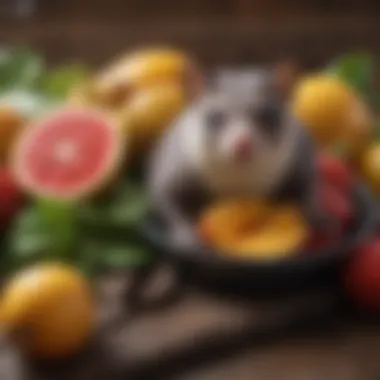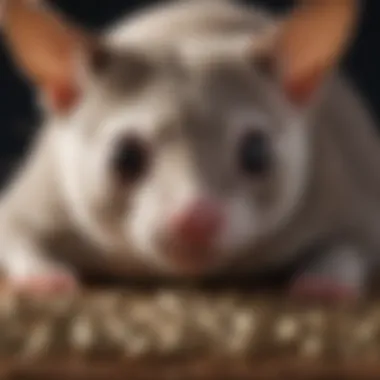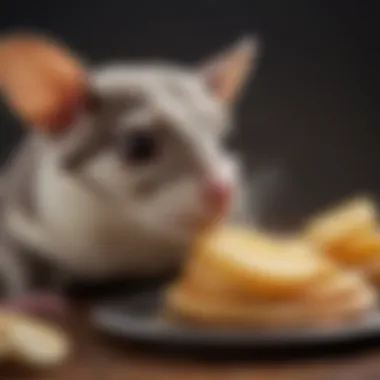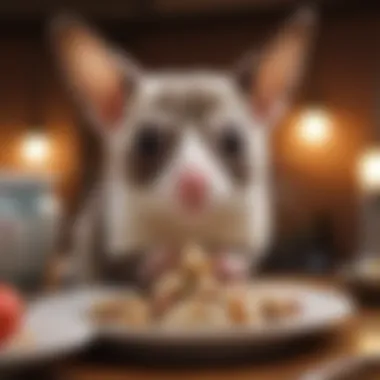Understanding the Diet of Pet Gliders: Essential Guide


Intro
Understanding the diet of pet gliders, especially sugar gliders, is crucial for their health and well-being. These small marsupials require a balanced and varied diet to thrive. It is essential to know what nutrients they need, how to prepare their meals, and what mistakes to avoid. By focusing on the dietary requirements, owners can ensure their pets live a long and healthy life.
Understanding Your Pet
Pet Behavior Basics
Sugar gliders are incredibly social animals. They communicate using various vocalizations and body language. Understanding these behaviors helps owners recognize when their pets are happy, distressed, or in need of attention. Moreover, they are nocturnal creatures, being most active during the night. This behavior influences not just their feeding schedule but also their overall habitat needs.
Common Breed Characteristics
Sugar gliders are known for their friendly nature and agile movements. They have a gliding membrane that extends from their wrists to their ankles. This allows them to glide between trees in the wild. Their size is generally small, measuring about 5 to 6 inches in length, not including the tail. Recognizing these characteristics helps owners create the best environment for their pet's physical and emotional health.
Species-Specific Needs
Every species has unique dietary requirements. For sugar gliders, a diet high in protein, fresh fruits, and vegetables is critical. Common dietary components include insect protein and specialized pelleted foods designed specifically for them. Understanding these needs is essential for avoiding nutritional deficiencies.
Pet Care and Maintenance
Feeding Guidelines
Feeding sugar gliders involves balancing their meals with appropriate nutrients. Here are some essential guidelines:
- Protein Sources: Utilize high-quality insect protein like mealworms or crickets.
- Fruits and Vegetables: Fresh sources like apples, berries, and leafy greens should be offered daily.
- Specialized Pellets: Include products like OHP Premium Glider Food as part of their diet.
Regularly rotating food types helps prevent boredom and ensures a broader nutrient intake.
Grooming Essentials
Proper grooming practices are part of maintaining a healthy sugar glider. Regularly check their fur for mats or dirt and trim their nails to prevent injury during playtime. Bathing should be minimal, as gliders usually groom themselves.
Hygiene Practices
Maintaining a clean living space is also vital. Regularly clean their cage and remove uneaten food to prevent mold or pests. A clean habitat contributes to their overall health and well-being.
Health and Wellness
Routine Vet Check-ups
Routine veterinary check-ups should not be overlooked. A specialist in exotic pets should examine your sugar glider at least once a year to assess their health.
Vaccination Needs
While sugar gliders generally do not require vaccinations, consulting with a veterinarian is advisable about any specific needs or guidelines.
Recognizing Signs of Illness
Being vigilant about your pet's health is crucial. Symptoms like lethargy, changes in appetite, or unusual behaviors can signal health issues. Quick action can prevent minor problems from escalating into severe ones.
Regular vet visits and attention to their behavior are key to maintaining health.
Enrichment and Activities
Indoor vs.
Outdoor Activities
Sugar gliders benefit from both indoor and outdoor play. Secure outdoor time allows them to explore but always supervise them to keep them safe.
Interactive Toys and Games
Provide interactive toys to stimulate their minds. Toys that encourage problem-solving or physical activity are particularly beneficial. For example, climbing structures mimic their natural environment and promote physical health.
Socialization Opportunities
Socialization is essential for their emotional well-being. Spend time daily interacting with them, allowing them to bond and feel secure. Consider introducing them to other pet gliders cautiously, ensuring that all pets are healthy and compatible.
Prologue to Pet Gliders


Understanding the diet of pet gliders is crucial for their health and well-being. These small marsupials have specific nutritional needs that must be met to ensure they thrive. When you decide to care for a sugar glider, you take on the responsibility of providing a balanced diet tailored to their unique metabolism and lifestyle.
Overview of Sugar Gliders
Sugar gliders are small, nocturnal marsupials native to Australia and New Guinea. They are known for their ability to glide through the air, thanks to a membrane stretched between their front and hind legs. These charming creatures are social and develop strong bonds with their owners. Because of their playful nature and captivating appearance, they have become increasingly popular as pets. However, as with any pet, ensuring their health involves understanding their dietary requirements.
Pet owners must recognize that these gliders are not just cute additions to the family. They require a well-rounded diet, rich in essential nutrients. This responsibility includes incorporating fruits, vegetables, and proteins which align with their natural diet in the wild. Formal knowledge of what sugar gliders need will vastly improve their chances of being healthy and happy as pets, which makes it imperative to explore their dietary needs.
Why Diet Matters
Diet plays a pivotal role in the overall health of sugar gliders. Their well-being is significantly influenced by the nutrition they receive from their food. An improper diet can lead to serious health issues, including obesity, dental problems, and metabolic disorders.
Proper nutrition is essential for maintaining optimal health and longevity in sugar gliders.
Pet gliders rely on a mixture of macronutrients and micronutrients. Understanding the balance of these nutrients can prevent deficiencies and ensure strong immune system function. Moreover, a varied diet supports their energetic lifestyle and enhances their lifespan. When pet owners neglect the importance of diet, they risk compromising their sugar glider's quality of life.
Nutritional Needs of Sugar Gliders
Understanding the dietary needs of sugar gliders is crucial for their health and longevity. Proper nutrition contributes to their overall well-being, behavior, and even life span. Pet owners should be aware of specific dietary requirements to ensure their gliders thrive in a domesticated environment. This section will emphasize the essential elements of sugar glider nutrition, focusing on macronutrients and micronutrients.
Macronutrients
Proteins
Proteins are a fundamental part of a sugar glider’s diet. They help in building and repairing tissues, and are essential for growth. A high-protein diet supports the health of muscles and organs. Sugar gliders benefit from protein sources like cooked eggs, lean meats, and certain insects. These foods provide amino acids necessary for their bodily functions.
- Key characteristic: Proteins are made of amino acids, which are the building blocks of life.
- Benefits: A protein-rich diet can improve energy levels and promote a more active lifestyle.
- Disadvantages: Excess protein can lead to weight gain and kidney issues if not balanced with other nutrients.
Fats
Fats are another vital component of sugar glider diets. They serve as a concentrated source of energy and are important for hormone production and cell structure. Including fats in the diet supports overall energy needs, especially during active periods. Sources of healthy fats may include nuts and seeds.
- Key characteristic: Fats are energy-dense, providing more than twice the energy per gram than proteins or carbohydrates.
- Benefits: Fats help maintain a shiny coat and healthy skin.
- Disadvantages: Too much fat can lead to obesity and other health issues. Therefore, moderation is essential.
Carbohydrates
Carbohydrates are an important energy source for sugar gliders. They provide quick energy needed for their active lifestyle. Gliders can obtain carbohydrates from fruits, vegetables, and certain grains. This component supports daily activities and reflects their natural foraging behavior.
- Key characteristic: Carbohydrates can be simple or complex, providing varying energy levels.
- Benefits: Including fibers from certain carbohydrates can aid in digestion.
- Disadvantages: Over-reliance on high-sugar fruits can lead to obesity and health complications.
Micronutrients
Vitamins
Vitamins play a significant role in maintaining the health of sugar gliders. They are essential for various body functions, including vision, immune function, and skin health. Important vitamins for sugar gliders include Vitamin A, B group vitamins, and Vitamin E. Sources of these vitamins often include fruits and vegetables, such as carrots and leafy greens.
- Key characteristic: Vitamins are required in small amounts but are critical for overall health.
- Benefits: A balanced vitamin intake can prevent deficiencies and associated health issues.
- Disadvantages: Excessive vitamin intake, particularly fat-soluble vitamins, can be harmful.
Minerals
Minerals are equally important for sugar gliders. They support bone health, nerve function, and overall cellular function. Key minerals include calcium, phosphorus, and magnesium. A balanced intake of these minerals is necessary to avoid health problems like metabolic bone disease.
- Key characteristic: Minerals help in metabolic processes and structural functions.
- Benefits: Adequate mineral intake can prevent deficiencies and associated health risks.
- Disadvantages: An imbalance, such as too much phosphorus and not enough calcium, can lead to serious health issues.
It is essential to ensure a balanced intake of both macronutrients and micronutrients for the optimal health of sugar gliders. A well-rounded diet is a key factor in preventing dietary-related health issues.
Key Components of a Balanced Diet
A balanced diet is crucial for the well-being of pet gliders, especially sugar gliders. These small mammals require a variety of nutrients to thrive. It is not sufficient to merely provide food; rather, it is essential to consider the components that make up their diet. The right mix of macronutrients and micronutrients promotes health, supports growth, and ensures a good quality of life.
Fruits and Vegetables
Fruits and vegetables are vital parts of a sugar glider's diet. They provide natural sources of vitamins, minerals, and fiber. Items like apples, bananas, carrots, and leafy greens can be excellent choices. These foods not only add essential nutrients but also offer hydration. Sugar gliders are often drawn to sweet fruits, so it is beneficial to include these in moderation.
When selecting fruits and vegetables, aim for a diverse range. This variety helps in preventing boredom and encourages healthier eating habits. However, be cautious about some fruits that are high in sugar. Limiting such items ensures that gliders maintain a balanced sugar intake.
Key Points on Fruits and Vegetables:
- Choose multiple colors and types.
- Wash thoroughly to remove pesticides.
- Introduce new options gradually to avoid digestive issues.
Protein Sources


Protein is also a significant part of a sugar glider's diet. They need it for energy, muscle maintenance, and overall growth. Common protein sources include insects, eggs, and cooked chicken. These options provide not only the essential amino acids but also encourage natural foraging behaviors.
It is important to offer a range of protein sources. This will help ensure that the sugar gliders receive all necessary nutrients. Flying foxes, crickets, and mealworms can also serve as high-quality snacks. However, limit treats so that they do not exceed more than 20% of their daily caloric intake.
Considerations for Protein Sources:
- Rotate protein types to avoid deficiencies.
- Monitor how your glider reacts to new proteins.
- Ensure all proteins are fresh and safe for consumption.
Commercial Diets
Commercial diets can be another effective way to support a sugar glider's nutritional needs. These diets are specifically formulated for gliders and provide a balanced mix of required nutrients. Brands like [SunCoast][1] and [Wombaroo][2] create products designed to meet their dietary requirements
While commercial diets can simplify feeding, they should not be the sole source of nutrition. A mix of fresh produce and protein sources is still necessary for optimal health. Reading labels and understanding ingredient lists is important. Look for diets with whole ingredients and avoid those with excessive fillers or artificial additives.
Benefits of Commercial Diets:
- Convenience in feeding.
- Often nutritionally complete.
- Easy to store and use.
Feeding Guidelines for Sugar Gliders
Feeding guidelines are crucial for maintaining the health and well-being of sugar gliders. These guidelines serve as a roadmap for pet owners, helping them navigate the complexities of appropriate nutrition for their gliders. A balanced diet not only contributes to their physical health but also influences their behavior and longevity. By understanding feeding schedules, portion control, and the introduction of new foods, owners can ensure their pet gliders thrive.
Daily Feeding Schedule
Establishing a daily feeding schedule is essential for sugar gliders. Unlike many pets, sugar gliders are nocturnal, meaning they are most active during the night. This behavior affects their feeding patterns. A typical schedule may include offering food in the evening, aligning with their natural activity. Consistency in feeding times helps gliders adjust to their routine and can also aid in their digestive health.
- Meal Frequency: Two main meals each day is often sufficient, but some owners prefer offering smaller snacks throughout the night.
- Timing Considerations: Careful timing is crucial. Avoid feeding during the day when they sleep, as this can waste food and disrupt their routine.
Portion Control
Portion control is vital to avoid obesity and related health issues in sugar gliders. Owners should keep track of how much food they give and adjust based on their glider's weight and activity level. Sugar gliders do not have an innate sense of portion sizes like some other animals, so it falls on the owner to manage this aspect.
- Recommended Portions: A good rule of thumb is to offer about one to two tablespoons of food per glider per meal. This includes a mix of fruits, vegetables, and proteins.
- Observing Weight Changes: Regularly monitor weight and adjust portions accordingly. If a glider begins to gain too much weight, reducing portions or changing the food types may be necessary.
Introducing New Foods
Introducing new foods to sugar gliders should be done gradually to avoid digestive issues. Sugar gliders are creatures of habit, and sudden changes can lead to stress or refusal to eat. Allowing them to adjust is critical for their acceptance of new ingredients.
- Gradual Introduction: Start by mixing a small amount of the new food with familiar favorites. Observe their reaction before increasing the quantity.
- Watch for Reactions: Pay attention to any adverse reactions such as diarrhea or lethargy, which may indicate an intolerance to the new food.
"Slow and steady wins the race when it comes to a sugar glider’s diet. Gradual changes are key to ensuring your pet's health and comfort."
By following these feeding guidelines, pet owners can significantly contribute to the health and happiness of their sugar gliders. Adapting to their unique needs in regards to feeding times, portion sizes, and new food introduction creates a stable environment that enhances their overall well-being.
Common Dietary Mistakes
Understanding common dietary mistakes is crucial for maintaining the health of pet gliders, especially sugar gliders. Many owners might think they are feeding their pets correctly, but small errors can lead to significant health issues. The failure to recognize these mistakes can contribute to malnutrition, obesity, and other serious health problems. Educating oneself about these common pitfalls is essential for ensuring the well-being of these animals, as it allows pet owners to create a more informed diet plan that meets the nutritional needs of their sugar gliders.
Overfeeding and Obesity
One of the most prevalent issues among pet gliders is overfeeding. Sugar gliders have a natural tendency to eat a variety of foods. However, when they are kept in captivity, they may not have the same level of activity that they would in the wild. This discrepancy can lead to weight gain and obesity.
Overfeeding can occur when owners misinterpret hunger cues. Sugar gliders may beg for food, but this does not always indicate a need for more food. It is essential to establish a proper feeding routine. Here are some things to consider:
- Portion Sizes: Understand the appropriate portion sizes for your glider's age and weight.
- Daily Feeding: Feed your sugar glider twice daily, allowing for breaks between meals.
- Signs of Obesity: Watch for signs such as lethargy or difficulty in grooming themselves.
Regular monitoring of your pet's weight can help combat these issues effectively.
Neglecting Nutrient Variety
Another common dietary mistake is failing to provide a diverse range of nutrients. Sugar gliders are omnivores in the wild, feeding on fruits, insects, and small animals. When their diet is not varied enough, certain vitamins and minerals can be lacking. This can cause nutritional deficiencies that lead to serious health problems.
To prevent this, pet owners should:
- Incorporate Different Foods: Include various fruits, vegetables, and protein sources in their diet.
- Rotate Foods: Change the offerings frequently to ensure that the glider receives different nutrients.
- Use Supplements: Consult with a veterinarian to understand if specific supplements are beneficial.
Neglecting to provide nutrient variety can also lead to boredom in your glider, which can impact their mental well-being.
Reliance on Inappropriate Foods
Many sugar glider owners make the mistake of relying on inappropriate foods or treats for their pets. Some common human foods or processed snacks can be harmful. Foods like chocolate, caffeine, or foods high in sugar can adversely affect their health.


It's important to avoid:
- High Sugar Foods: Foods like candy or sweetened yogurts should be kept away from your glider's diet.
- Processed Foods: Many processed items designed for humans contain additives that can be toxic for sugar gliders.
The best approach is to educate oneself on what foods are safe and what foods should be avoided. Always prioritize fresh and natural foods for your pet glider’s diet. It can make a significant difference in their overall health.
Remember, providing a balanced diet is not just about what is included but also what is excluded. This knowledge empowers pet owners to make informed decisions regarding their sugar gliders' diets.
Health Issues Related to Diet
Understanding the relationship between diet and health is crucial for pet gliders. These small marsupials, particularly sugar gliders, require a carefully balanced diet to thrive. An inadequate diet can lead to various health issues, impacting their overall well-being and longevity. By recognizing the potential diet-related problems, pet owners can take proactive steps to optimize their gliders' health.
Nutritional Deficiencies
Nutritional deficiencies occur when a sugar glider's diet lacks essential vitamins and minerals. These deficiencies can lead to serious health complications. For instance, a deficiency in calcium can result in metabolic bone disease, characterized by weak bones and deformities. Similarly, a lack of vitamin A can cause eye problems and poor coat health.
To prevent nutritional deficiencies:
- Diversify the diet: Offering a variety of foods can help ensure that the glider receives all necessary nutrients.
- Incorporate fresh fruits and vegetables: These not only provide vitamins but also minerals that are vital for health. Consider options like spinach, carrots, and fruits such as kiwi and papaya.
- Use supplements wisely: If needed, specific vitamin supplements can support their diet. Always consult a vet before adding supplements.
Regular veterinary check-ups can help identify deficiencies before they become serious. Observation of the glider's behavior and physical condition is also key. Signs such as lethargy, weight loss, or changes in fur quality may indicate nutritional issues.
Metabolic Disorders
Metabolic disorders can arise from improper dietary habits in sugar gliders. These disorders often stem from an imbalance in nutrients, particularly an excess of carbohydrates or inadequate protein intake. One common issue is hyperglycemia, which can develop from high sugar diets.
Symptoms of metabolic disorders include:
- Weight gain or loss
- Lethargy
- Poor grooming
- Behavioral changes
To avoid metabolic disorders:
- Monitor food intake: Be aware of portion sizes and avoid overfeeding. Keep sugary treats to a minimum.
- Choose appropriate food: Look for diets specifically formulated for sugar gliders that balance protein, fats, and carbs effectively.
- Stay informed about dietary needs: Consult with a veterinarian to understand the unique metabolic requirements of your pet glider.
By remaining vigilant about diet and health, pet owners can significantly contribute to the quality of life for their sugar gliders. Proper nutrition is essential not only for physical health, but also for maintaining a happy and active glider.
Practical Tips for Pet Owners
Understanding how to care for pet gliders can be complex, and choosing the right diet is crucial for their health. This section offers practical tips that are essential for pet owners. These strategies not only ensure that sugar gliders get the right nutrients but also help in maintaining their overall well-being. By following these guidelines, pet owners can foster a healthy environment for their gliders.
Selecting Quality Food Products
When it comes to selecting food for sugar gliders, quality matters significantly. Pet owners should prioritize nutrient-dense products. Look for brands that provide a complete nutritional profile, featuring both macronutrients and micronutrients. Ingredients should reflect natural sources, avoiding unnecessary fillers or artificial preservatives. Products specifically designed for sugar gliders are often more reliable than general pet food options.
Consider examining the first few ingredients listed on the label. Ingredients should ideally include high-quality protein sources, various fruits, and vegetables. Avoid products that list corn or wheat as the primary ingredient, as these are less beneficial for gliders, and stick to items like:
- Insects (like mealworms or crickets)
- Fruits (such as apples and berries)
- Vegetables (like sweet potatoes and carrots)
Consult with a veterinarian to understand the best brands available. It is advisable to switch brands slowly when necessary to avoid upsetting your glider's digestive system.
Monitoring Food Intake
Monitoring what your sugar glider eats is as crucial as what they eat. Portion control is vital in preventing obesity, which can lead to several health issues. A good practice is to measure the daily food portions according to the glider's age, weight, and activity level.
Keep track of any changes in behavior or weight after adjusting portions. Signs of overfeeding may include lethargy or difficulty climbing. Creating a feeding regimen helps maintain consistency. For instance:
- Daily Mealtimes: Establish specific times to feed your glider each day.
- Use of Smart Feeding Bowls: Consider using bowls that help limit portions or track consumption.
- Regular Weigh-ins: Weigh your sugar glider periodically to ensure they maintain a healthy weight.
Monitoring food intake and maintaining a proper diet can significantly extend the life of your sugar glider.
These practical tips aim to simplify the responsibilities of pet owners. By focusing on quality and monitoring food intake effectively, pet owners can contribute to a thriving and happy pet glider.
Finale
Understanding the dietary requirements of pet gliders, particularly sugar gliders, is pivotal for their health and well-being. A comprehensive grasp of their nutritional needs allows pet owners to select appropriate foods and create balanced diets that promote longevity and vitality.
Recap of Key Points
- Nutritional Needs: Sugar gliders require a mix of proteins, fats, and carbohydrates. This mix is essential for their physical growth and energy.
- Key Components: Incorporating fruits, vegetables, and proteins into their diet ensures they receive essential amino acids and vitamins necessary for overall health.
- Common Mistakes: Overfeeding and neglecting variety can lead to obesity and other health issues, highlighting the need for careful monitoring.
- Health Concerns: Awareness of potential nutritional deficiencies and metabolic disorders can prevent serious health problems in sugar gliders.
Future Considerations for Pet Glider Care
As pet owners, it is important to stay updated on evolving research regarding sugar gliders' nutritional needs. The understanding of their diets may change as new studies emerge. Here are some considerations moving forward:
- Innovative Diet Plans: Explore new commercial diets tailored for sugar gliders that may be more nutritious or beneficial than traditional options.
- Engaging with Communities: Participate in forums and social media groups focused on sugar gliders. Platforms like reddit.com can be a great source for shared experiences and knowledge.
- Regular Veterinary Advice: Regular check-ups with a veterinarian who understands exotic pets can ensure that dietary practices remain aligned with the best health for your glider.
By applying these insights and remaining vigilant about their diets, pet owners will contribute positively to the quality of life of their sugar gliders.







